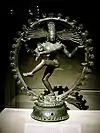Shri Rudram
Shri Rudram (Sanskrit: श्रीरुद्रम्, romanized: śrī-rudram), is a Vedic mantra or chant in homage to Rudra (an epithet of Shiva) taken from the Krishna Yajurveda's Taittiriya Samhita (TS 4.5, 4.7). It comprises two parts, the Namakam and Chamakam. Chamakam (Sanskrit: चमकम्) is added by scriptural tradition to the Shri Rudram.[1][2] Shri Rudram is also known as Śri Rudrapraśna, Śatarudrīya and Rudradhyaya. The text is important in Shaivism, where Shiva is viewed as the ultimate God. The hymn is an early example of enumerating the names of a deity.[3]
| Part of a series on |
| Shaivism |
|---|
 |
| Part of a series on |
| Hindu scriptures and texts |
|---|
 |
| Related Hindu texts |
Shri Rudram is also famous for its mention of the Shaivite holy mantra Namah Shivaya, which appears in the text of the Śatarudrīya in the eighth anuvāka of Taittiriya Samhita (TS 4.5.8.1).[4] It also contains the mantra Aum namah bhagavate rudraya and the Mahamrityunjaya Mantra.[5][6][7][8]
Text
Shri Rudram consists of two chapters (praśna) from the fourth kāṇda (book) of Taittiriya Samhita which is a part of Krishna Yajurveda.[9] The names of the chapters are Namakam (chapter five) and Chamakam (chapter seven) respectively.[10] The Namakam (chapter five) in Shri Rudram describes the names or epithets of Rudra, who is a fear-inducing aspect of Shiva. Additionally, the devotee asks for the benevolent aspect of Shiva to be invoked rather than the terrible aspect of Rudra and requests for forgiveness of sins. The Chamakam (chapter seven) asks for the fulfillment of wishes.[11] Each chapter consist of eleven anuvākas or hymns.[12][13][14]
The anuvākas or hymns of Namakam correspond to the eleven hymns of TS 4.5, with the final hymn extended by an additional eight verses, including the Mahamrityunjaya Mantra.[15][16][17] The mantra Om Namah Shivaya is derived from the Shri Rudram, in which it appears in TS 4.5.8.1 though without the syllable Om.[18][19][20][21][22] The anuvākas or hymns of Chamakam correspond to TS 4.7 and they ask God for fulfillment of wishes.[23]
The earliest homage hymns to Rudra is the Śatarudrīya found in the Yajurveda (TS 4.5.1-11, VS 16.1-66).[24][25] C. Fuller maintains that Shri Rudram is based on Śatarudrīya.[3]
See also
Notes
- "Śrī Rudram Exosition" (PDF).
- "Introduction to rudram". sec. Chamakam.
- C Fuller (2001), Orality, literacy and memorisation: priestly education in contemporary south India, Modern Asian Studies, Vol. 35, Issue 1, pages 14-15 with footnote 6
- For notability and text namaḥ śivāya see: Sivaramamurti, pp. 1, 24.
- "sri rudram" (PDF). pp. 4–5.
- "SRI RUDRAM with meaning" (PDF). sec. Mantra.
- "SRI RUDRAM (with CHAMAKAM)" (PDF). sec. mantra 12 of ANUVAKAM 11, page 87.
- "Rudram" (PDF). vedic union. p. 2.
- "Introduction to Rudram". sec. What is Rudram ?.
- "Sri Rudram - Hindupedia, the Hindu Encyclopedia". www.hindupedia.com.
- "Introduction to Rudram". sec. Chamakam.
- "Sri rudram Exposition" (PDF).
- "Introduction to rudram". sec. What is Rudram ?.
- "Sri rudram". sec. First paragraph.
- "Si rudram" (PDF). www.skandagurunatha.org. p. 5.
- "Rudram" (PDF). sec. Anuvāka 11 of Namakam (Supplement), page 31.
- "SRI RUDRAM with meaning" (PDF). sec. Mantras.
- "Rudram" (PDF). vedaunion. p. anuvaka 8 of Namakam at page-22.
- "sri rudram exposition (search for "namaḥ śivāya ca śivatarāya ca" in the pdf at page 3)" (PDF). vedaunion.org. p. 3.
- "sri-rudram" (PDF). skandagurunatha.org. p. 4.
- "Sri Rudram - Introduction". www.manblunder.com.
- "which verse of sri rudram of yajurveda has word shiva (search as "Most importantly 1st verse of 8th Anuvaka mentions the word Shiva as")". hinduism.stackexchange.
- "Sri Rudram". sec. Methods of Chanting Rudra.
- Stella Kramrisch (1988). The Presence of Siva. Motilal Banarsidass. pp. 71–73. ISBN 978-81-208-0491-3.
- For a full translation of the complete hymn see: Sivaramamurti (1976)
References
- Flood, Gavin (1996). An Introduction to Hinduism. Cambridge: Cambridge University Press. ISBN 0-521-43878-0.
- Kramrisch, Stella (1981). The Presence of Śiva. Princeton, New Jersey: Princeton University Press. ISBN 0-691-01930-4.
- Sivaramamurti, C. (1976). Śatarudrīya: Vibhūti of Śiva's Iconography. Delhi: Abhinav Publications.
External links
| Wikisource has original text related to this article: |

